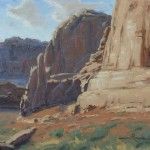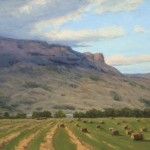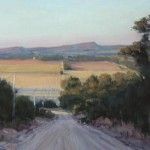Chuck Rawle finds inspiration in America’s wild places
By Rosemary Carstens
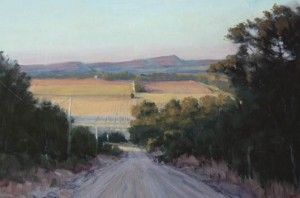
Chuck Rawle, The Golden Hour, oil, 12 x 16.
When country western legend Waylon Jennings sang I’m a Ramblin’ Man, about roaming the West, he could have been talking about landscape painter Chuck Rawle. In 1998, after a 31-year career with Central Freight Lines in Irving, TX, Rawle took his rapidly developing skills as an artist on the road. He and his wife sold their home, bought an RV, and began traveling full time throughout the United States and Canada, even dipping south of the border into Mexico. Rawle says painting outdoors almost every day has contributed exponentially to his art education. His abiding love of nature and the North American landscape, combined with his passion for his art, make him feel like “one of the luckiest guys around.”
Rawle credits Winston Churchill with inspiring him to take up painting as a second career. He read an article about Churchill’s book Painting as a Pastime, in which Churchill makes a case for the all-absorbing activity of painting (particularly plein-air painting) as an escape from stress and overwork. Rawle was fascinated—and motivated—by the statesman’s adamant recommendation that the older painter should not hesitate but simply get on with it, that painting is “a joy ride in a paint box,” for which “audacity is the only ticket.”
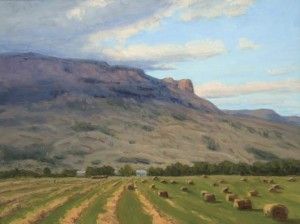
Chuck Rawle, Summer Hay, oil, 12 x 16.
From that time forward, Rawle dove wholeheartedly into the study of art, seeking out the best instructors he could find. He joined several artists’ organizations and took a workshop from well-known impressionist Kevin Macpherson. Although Rawle tried his hand at still lifes, he says, once he began painting outdoors, “It was a whole new ballgame.” He’d found his niche and began studying with masters such as Scott Christensen, whom Rawle says has had perhaps the greatest influence on him: “He really spurred me on. I especially admire his color harmony, and how he orchestrates his compositions.” Another major influence has been painter Matt Smith. “Watching Matt’s brushwork,” says Rawle, “is like watching a world-class conductor at work.”
Born in the small town of Vernon, TX, Rawle grew up in nearby Wichita Falls and stayed there through his second year of college. He and his wife, Mary (who runs their online art supply business, Wind River Arts, and builds websites for artists and galleries), have known each other since the eighth grade and just celebrated their 47th wedding anniversary. They typically spend winters in Fredericksburg, TX, and summers in the mountains of New Mexico, Colorado, Wyoming, and Canada, winding their way through the great Rocky Mountains. They have also explored the United States coast to coast, from the lush greenery of the Pacific Northwest to the sandy beaches of the Outer Banks of North Carolina and south to the turquoise waters of Key West.
Rawle has always had an appreciation for the land, and traveling has reinforced his admiration. “We feel blessed to live in the United States. There is no end to exceptional scenery,” says Rawle. “Each region has its own unique beauty. And in the West much of it is still there, just as it was for 19th-century painters like Thomas Moran and Albert Bierstadt.” He adds that traveling has also given him new appreciation for the friendliness of the American people: “I can’t tell you how many times I’ve set up my easel on a roadside, and the owner comes out and invites me in for coffee or takes me on a tour of his land.”
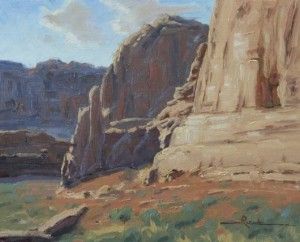
Chuck Rawle, Canyon Colors, oil, 8 x 10.
Although Rawle did not become involved in art early on in life, the 64-year-old artist says he’s always had a creative side. He played trumpet and French horn in school and sang in an a capella choir. He loves a wide variety of music, having grown up to the beat of 1950s rock and roll and the twangy soulfulness of country western melodies. His iPod has close to 6,000 songs on it, from Richard Clayderman on the piano to Ottmar Liebert playing classical guitar to traditional Dixieland jazz. And he’s been known to sing while he paints.
Rawle describes himself as a “quiet, introspective kind of guy” who seldom gets frustrated or upset, a patient teacher, and a persistent artist who continues to work diligently at his craft. He gets a kick out of teaching and conducts two to three workshops a year. He is a man who has mastered the art of contentment and, when not working, enjoys baseball and gardening. He brags on Mary’s cooking and loves Mexican food and a good chicken-fried steak.
The recipient of numerous awards at shows across the country, Rawle is represented by several galleries in Texas, as well as in Idaho, Wyoming, and North Carolina. One of those is Kneeland Gallery in Ketchum, ID, where Rawle had a solo show last fall. “Chuck’s show coincided with Ketchum’s annual Trailing of the Sheep Festival,” says gallery director Carey Molter. The event celebrates the heritage of sheep-raising in Idaho. “To tie into that event, I asked Chuck to paint one or two local scenes with sheep and wagons incorporated. He produced a lovely study of a dusty procession of sheep followed by a rider on horseback, which was a popular piece in his show. I have great respect for an artist who will step out of his comfort zone in this way and push the boundaries of his work to make himself a better artist.”
When on the road, Rawle frequently does field studies, sometimes capturing scenes alla prima. He loves the immediacy of laying down a grand view just as he feels and sees it at that very moment. For example, the painting OXBOWS, one of his favorites, was done on location east of Moran, WY, just north of Jackson Hole. “Rivers have always appealed to me, and I just couldn’t pass up this scene where the river cuts vast, sweeping curves across the valley floor,” says the artist. “It was a beautiful fall day, about 75 degrees with a light breeze, and the drama of the scene drew me in.”
One of Rawle’s greatest strengths is his determination to convey the balance between nature’s visual and emotional components. “There’s a story behind every painting,” he says. “Even when I come across a piece I did several years ago, just seeing it brings back where I was, what I was doing, who I was with, what the weather was like—so many details jump out of my memory. It’s that added emotional element that I want viewers to experience.”
Shannon Hanna, co-owner of InSight Gallery in Fredericksburg, TX, confirms Rawle’s dedication to his craft. “I’ve come to realize how much he appreciates the ‘adventure’ of painting,” Hanna says. “During his travels, Chuck constantly seeks out other artists, making time to talk with and learn from them. Instruction and knowledge development are very important to him.”
Recently, Rawle and his wife decided to buy a home in Richmond, TX, where Mary’s family lives. He wanted a studio where he could work on larger paintings and prepare for shows. They found just what they were looking for, a house near open space and a lake. He’s gained fresh inspiration from the many nearby painting sites: a bayou, fields of wild iris, an old Anglican church, and miles of prairie-like terrain dotted with old forests. Brazos Bend State Park is close by and is one of his favorite places. “I love the live oaks,” Rawle says. “After they’ve been around for a hundred years or so, they become very interesting characters.”
Inside their home, Rawle’s high-ceilinged studio features a massive easel and a good-sized taboret. His setup allows easy access to the limited palette he prefers—one red, one blue, one yellow (“the primaries plus white”). He mixes grays from those hues as needed. “Working with a limited palette really frees you up,” says the artist. “You are liberated by simplifying your choices, and it improves the color harmony of your work.” Rawle’s mastery of color harmony is readily apparent in CANYON COLORS (above), a scene showing the canyon country of the Southwest, with the sun-bleached pastels of a weathered landscape that has survived for centuries.
For Rawle, art is “a way to communicate.” To counter the rapid-fire pace of today’s culture, he likes to portray landscapes with just a touch of nostalgia. His paintings offer his viewers a way to absorb the essential beauty and serenity of the land. The scenes he chooses suggest the value of slowing down, taking a deep breath, and reconnecting with nature’s bounty. “Art helps us escape, calms and relaxes us—these are my goals in my work,” says Rawle. “In my painting, I feel I have found my true voice.”
Dossier
Representation
InSight Gallery, Fredericksburg, TX; Collectors Covey, Dallas, TX; Riverbend Fine Art, Marble Falls, TX; Morton Street Gallery, Richmond, TX; Kneeland Gallery, Ketchum, ID; Galleries West Fine Art, Jackson, WY; Germanton Art Gallery, Germanton, NC; www.chuckrawle.com.
Featured in July 2010
- Chuck Rawle, Canyon Colors, oil, 8 x 10.
- Chuck Rawle, Summer Hay, oil, 12 x 16.
- Chuck Rawle, The Golden Hour, oil, 12 x 16.






